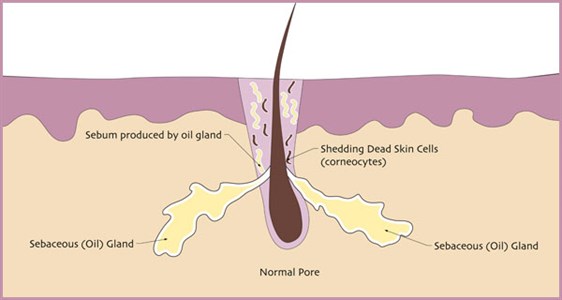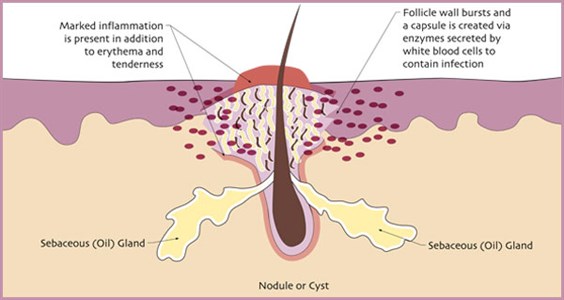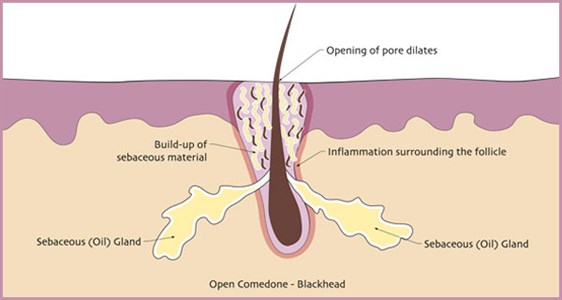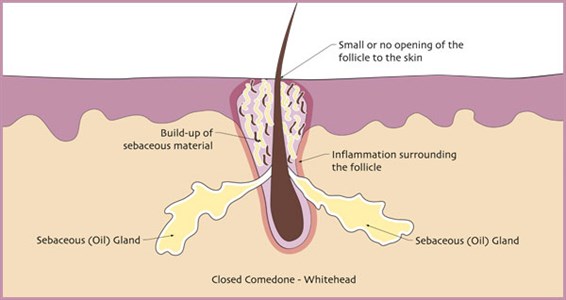What is Acne?
What is Acne?
For most people, acne is an inherited condition of the pores. When someone is prone to acne, their pores clog with dead skin cells much faster than normal. Healthy pores shed about one layer of dead skin cells per day inside the pore, but acne-prone pores shed up to five layers of dead skin cells per day. The body just can't keep up with keeping the pore clear. Technically, this is called "retention hyperkeratosis" – dead skin cells shedding more quickly than the pore can expel them.
As the dead skin cells begin to accumulate inside the pore, the cells become sticky and get stuck inside the pore and form a plug. Medically, this is called a "microcomedone" - essentially the precursor to all acne.
Hormonal fluctuations trigger more oil production inside the pore. Normally, this isn't a problem because the dead skin cells don't get trapped. But with acne prone-skin, when the dead skin cells shed more quickly and form a blockage, the perfect environment for the P. Acnes bacteria is created. The oil is a nutrient for the bacteria, so the bacteria proliferates. So you see, bacteria is not the "cause" of acne, it is the effect of too many dead skin cells. This is an important distinction to remember.
But, some people don't get inflamed lesions – inflammation is also an inherited tendency. If the dead skin cells and the oil that form the plug don't become inflamed, the plug becomes a whitehead; that is, a non-inflamed lesion under the skin, also called a "closed comedone".
Or the plug can become a blackhead, which is a non-inflamed acne lesion where the pore remains open, also known as an "open comedone." In the case of a blackhead, the tip of the plug darkens as it is exposed to oxygen in the environment. As the oil in the pore builds up, inflammation can develop in the cells surrounding the pore. Blackheads can be infected or not depending on whether the P. Acnes bacteria have affected the cells around the pore.
As the oil and the dead skin cells build up, they put pressure on the cells surrounding the pore. With enough pressure, the sides of the pore rupture and the contents of the pore leak into the surrounding skin. Because this sebaceous material contains a lot of P. acnes bacteria, the surrounding skin now becomes infected, creating a red bump that we know as a pimple. The medical term for this red bump is an inflammatory papule.
Conclusion:
As you can see, acne is primarily an inherited dead skin cell problem. Most acne, no matter what form it takes, starts with microcomedones. This means the solution lies in products that penetrate the pore and prevent dead skin cells from building up. That's why your home care routine is so crucial – it's all about preventing the microcomedones (the beginning of acne) from forming at all.
HOW TO GET CLEAR SKIN
Pore Clogging Ingredients in Skin Care
Some of the worst offenders of clogging pores and irritating acne are those skin care products and hair care products that contain pore-clogging ingredients. Natural oils like cocoa butter and coconut oil which are found in many “organic” skin care lines will wreak havoc with acne-prone skin. Infact, many professional skin care products, natural skin care products, organic skin care products and even acne skin care products can have pore-clogging ingredients. No government agency oversees this, so skincare companies can claim their products promote clear skin and still have pore cloggers in their ingredient deck.
Did you know that prescription Retin A (cream form) contains isopropyl myristate- a potent pore-clogger. Some other prescription products are comedogenic as well. Many over-the-counter acne medications also have pore clogging ingredients. “Oil-free” products are not necessarily safe either.
Just like skin care products there are numerous hair care lines that contain ingredients like sodium laureth sulfate or sodium lauryl sulfate both of which are high on the comedogenic (pore-clogging) scale and are found in a multitude of shampoos and hair care products. Other oils such as jojoba, olive and lanolin are mildly comedogenic (pore clogging) and can be a problem if formulated with other comedogenic ingredients.
So a word to the wise, don’t ever put anything on your skin or hair without checking the ingredients first! Remember even if it says “noncomedogenic”, “oilfree” or “won’t clog your pores” on the bottle that doesn’t mean it’s safe to use on your acne prone skin. Always check the products ingredient deck for pore cloggers before using any products on your face or in your hair.
List of pore-clogging (comedogenic) ingredients:
- Acetylated Lanolin
- Acetylated Lanolin Alcohol
- Algae Extract
- Algin
- Butyl Stearate
- Carrageenan
- Cetearyl Alcohol + Ceteareth 20
- Cetyl Acetate
- Chlorella
- Chondrus Crispus (aka Irish Moss or Carageenan Moss)
- Coal Tar
- Cocoa Butter
- Coconut Alkanes
- Coconut Butter
- Coconut Oil
- Colloidal Sulfur
- Cotton Awws Oil
- Cotton Seed Oil
- D & C Red # 17
- D & C Red # 21
- D & C Red # 3
- D & C Red # 30
- D & C Red # 36
- Decyl Oleate
- Dioctyl Succinate
- Disodium Monooleamido PEG 2- Sulfosuccinate
- Ethoxylated Lanolin
- Ethylhexyl Palmitate
- Glyceryl Stearate SE
- Glyceryl-3 Diisostearate
- Hexadecyl Alcohol
- Hydrogenated Vegetable Oil
- Isocetyl Alcohol
- Isocetyl Stearate
- Isodecyl Oleate
- Isopropyl Isostearate
- Isopropyl Linolate
- Isopropyl Myristate
- Isopropyl Palmitate
- Isostearyl Isostearate
- Isostearyl Neopentanoate
- Kelp
- Laminaria Digitata Extract
- Laminaria Saccharina Extract (Laminaria Saccharine)
- Laureth-23
- Laureth-4
- Lauric Acid
- Mink Oil
- Myristic Acid
- Myristyl Lactate
- Myristyl Myristate
- Octyl Palmitate
- Octyl Stearate
- Oleth-3
- Oleyl Alcohol
- PEG 16 Lanolin
- PEG 200 Dilaurate
- PEG 8 Stearate
- PG Monostearate
- PPG 2 Myristyl Propionate
- Plankton
- Polyglyceryl-3 Diisostearate
- Potassium Chloride
- Propylene Glycol Monostearate
- Red Algae
- Sea Whip Extract
- Seaweed
- Shark Liver Oil
- Sodium Chloride
- Sodium Laureth Sulfate
- Sodium Lauryl Sulfate
- Solulan 16
- Sorbitan Oleate
- Soybean Oil
- Spirulina
- Steareth 10
- Stearic Acid Tea
- Stearyl Heptanoate
- Sulfated Castor Oil
- Sulfated Jojoba Oil
- Wheat Germ Glyceride
- Wheat Germ Oil
- Xylene






